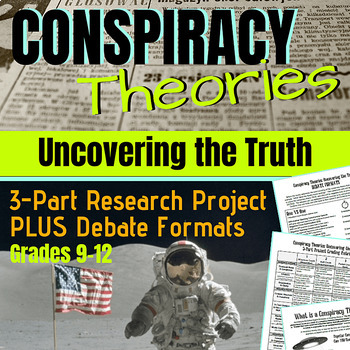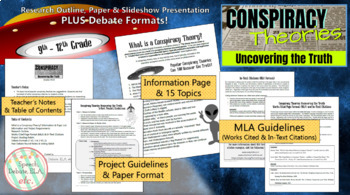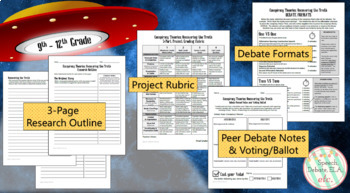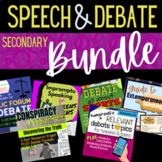Conspiracy Theories: Uncovering the Truth (3-Part Research Project PLUS Debate)
- PDF
- Internet Activities
What educators are saying
Also included in
- Need secondary speech and debate activities, but want to save money? I’ve put together 6 of my top-selling products, and you’re essentially getting one free! These activities were created for secondary students (grades 6-12), and you are welcome to modify each activity as necessary. Together, thesePrice $18.00Original Price $22.70Save $4.70
Description
If you’ve turned on the news lately, stood in line at the grocery store and browsed the magazines, or surfed the internet, then you know that conspiracy theories are everywhere! Some of the theories are so intriguing, we read further or turn up the volume. Others are so outrageous that we laugh in disbelief! How can we possibly separate fact from fiction when the media can be so convincing?
Some of the oldest conspiracy theories are still circulating today, from Bigfoot and alien sightings, to the “faked” moon landing and rumors that Elvis is still alive! In this 3-part research project, Conspiracy Theories: Uncovering the Truth (research outline, paper, and slideshow presentation) plus optional debate, your 9th-12th grade students can try to get to the bottom of some of the wildest conspiracy theories and decide for themselves what is real and what is fake.
This is a FUN project that your students will enjoy. Although there is a timed debate format, they will want to debate these conspiracy theories for hours!
Included in 11-Page PDF file:
-Teacher’s Notes & Table of Contents
-What is a conspiracy theory? Information & Topic List
-Info Sheet and Project Requirements
-Research Outline
-MLA Works Cited Page Format & In-Text Citations
-Project Grading Rubric
-Debate Formats (1 VS. 1 & 2 VS. 2)
-Peer Debate Round Notes & Voting Ballot
*UPDATE ON FILE 4/26/22-- This is now an "unlocked" PDF file so editing is possible if you need/want to add topics to the list or modify for you classes.
*The basics of MLA format are explained in this project and assessed on the grading rubric. You may implement a different format if you’d like.
Feel free to ask questions before purchasing. Enjoy!
Click the links below to check out some of my other research projects and activities for secondary students!
Debate for Kids & Tweens (Tips, Outlines, Rubrics & Other Resources)
Early Finisher Task Cards for Junior High Students
Logical Fallacies: Identifying 12 Flawed Arguments
10 Propaganda Techniques Mini-Unit, Secondary Education
Current Event Speech, Secondary Ed.
My First Research Paper (secondary)
Environmental Informative Speech & Technology-Based Presentation





